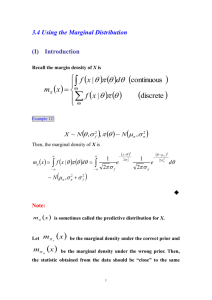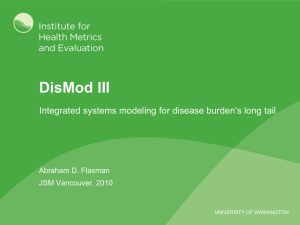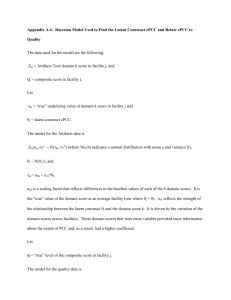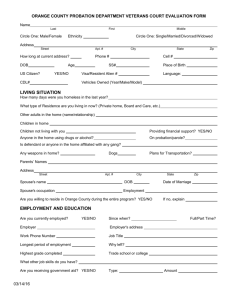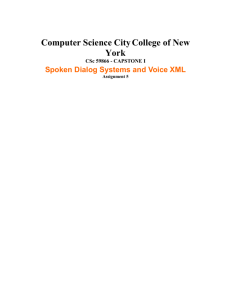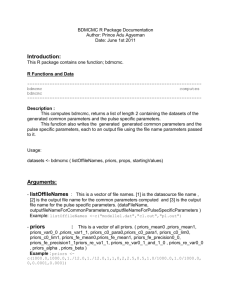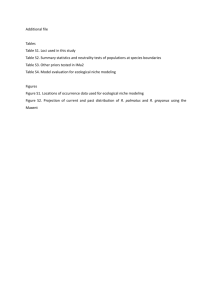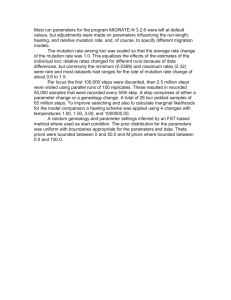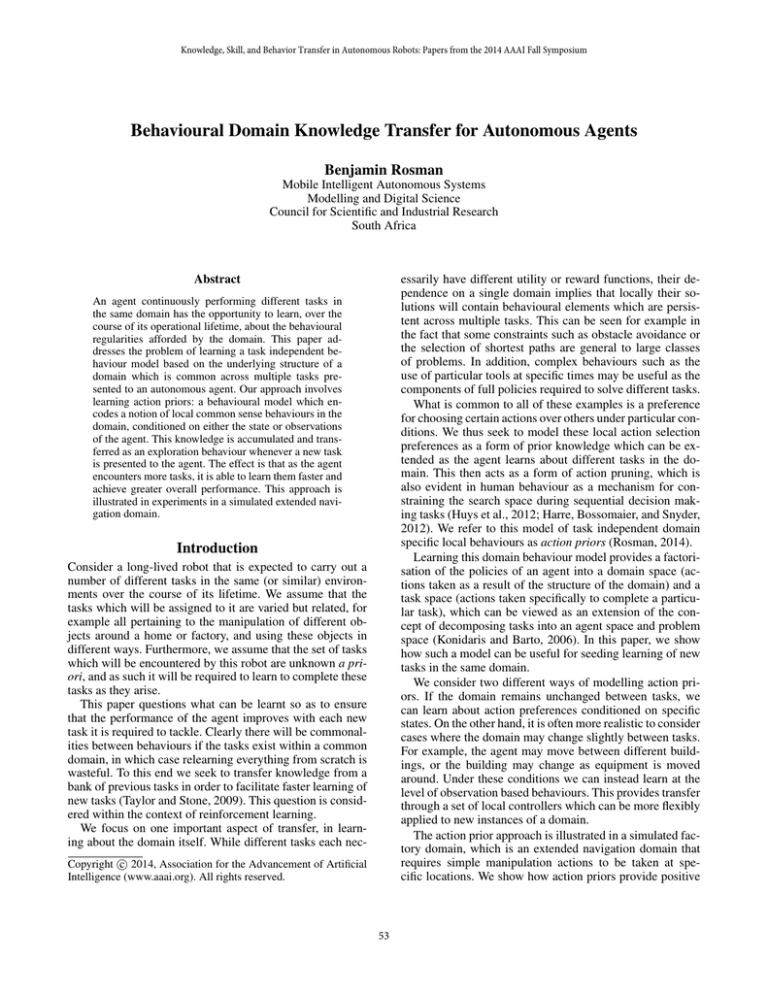
Knowledge, Skill, and Behavior Transfer in Autonomous Robots: Papers from the 2014 AAAI Fall Symposium
Behavioural Domain Knowledge Transfer for Autonomous Agents
Benjamin Rosman
Mobile Intelligent Autonomous Systems
Modelling and Digital Science
Council for Scientific and Industrial Research
South Africa
Abstract
essarily have different utility or reward functions, their dependence on a single domain implies that locally their solutions will contain behavioural elements which are persistent across multiple tasks. This can be seen for example in
the fact that some constraints such as obstacle avoidance or
the selection of shortest paths are general to large classes
of problems. In addition, complex behaviours such as the
use of particular tools at specific times may be useful as the
components of full policies required to solve different tasks.
What is common to all of these examples is a preference
for choosing certain actions over others under particular conditions. We thus seek to model these local action selection
preferences as a form of prior knowledge which can be extended as the agent learns about different tasks in the domain. This then acts as a form of action pruning, which is
also evident in human behaviour as a mechanism for constraining the search space during sequential decision making tasks (Huys et al., 2012; Harre, Bossomaier, and Snyder,
2012). We refer to this model of task independent domain
specific local behaviours as action priors (Rosman, 2014).
Learning this domain behaviour model provides a factorisation of the policies of an agent into a domain space (actions taken as a result of the structure of the domain) and a
task space (actions taken specifically to complete a particular task), which can be viewed as an extension of the concept of decomposing tasks into an agent space and problem
space (Konidaris and Barto, 2006). In this paper, we show
how such a model can be useful for seeding learning of new
tasks in the same domain.
We consider two different ways of modelling action priors. If the domain remains unchanged between tasks, we
can learn about action preferences conditioned on specific
states. On the other hand, it is often more realistic to consider
cases where the domain may change slightly between tasks.
For example, the agent may move between different buildings, or the building may change as equipment is moved
around. Under these conditions we can instead learn at the
level of observation based behaviours. This provides transfer
through a set of local controllers which can be more flexibly
applied to new instances of a domain.
The action prior approach is illustrated in a simulated factory domain, which is an extended navigation domain that
requires simple manipulation actions to be taken at specific locations. We show how action priors provide positive
An agent continuously performing different tasks in
the same domain has the opportunity to learn, over the
course of its operational lifetime, about the behavioural
regularities afforded by the domain. This paper addresses the problem of learning a task independent behaviour model based on the underlying structure of a
domain which is common across multiple tasks presented to an autonomous agent. Our approach involves
learning action priors: a behavioural model which encodes a notion of local common sense behaviours in the
domain, conditioned on either the state or observations
of the agent. This knowledge is accumulated and transferred as an exploration behaviour whenever a new task
is presented to the agent. The effect is that as the agent
encounters more tasks, it is able to learn them faster and
achieve greater overall performance. This approach is
illustrated in experiments in a simulated extended navigation domain.
Introduction
Consider a long-lived robot that is expected to carry out a
number of different tasks in the same (or similar) environments over the course of its lifetime. We assume that the
tasks which will be assigned to it are varied but related, for
example all pertaining to the manipulation of different objects around a home or factory, and using these objects in
different ways. Furthermore, we assume that the set of tasks
which will be encountered by this robot are unknown a priori, and as such it will be required to learn to complete these
tasks as they arise.
This paper questions what can be learnt so as to ensure
that the performance of the agent improves with each new
task it is required to tackle. Clearly there will be commonalities between behaviours if the tasks exist within a common
domain, in which case relearning everything from scratch is
wasteful. To this end we seek to transfer knowledge from a
bank of previous tasks in order to facilitate faster learning of
new tasks (Taylor and Stone, 2009). This question is considered within the context of reinforcement learning.
We focus on one important aspect of transfer, in learning about the domain itself. While different tasks each necc 2014, Association for the Advancement of Artificial
Copyright Intelligence (www.aaai.org). All rights reserved.
53
for each state s a distribution over the action set, representing the probability of each action being used in an optimal
policy in s, aggregated over the tasks T . This is then used as
a model of domain behaviour in subsequent tasks to prioritise the actions in each state.
For each state s ∈ S, let the action priors θs (A) be this
distribution over the action set A, describing the usefulness
of each action in optimally solving the tasks in T using the
policies Π. To construct these action priors, we first define
the utility of an action a in a state s under a policy π as
knowledge transfer when learning multiple tasks, using both
state and observation representations.
Domains and Tasks
Throughout this paper, we adopt the standard formalism
used in reinforcement learning and assume that a problem
faced by a learning agent is fully specified by a Markov
Decision Process (MDP). An MDP is defined as a tuple
(S, A, T, R, γ), where S is a finite set of states, A is a finite set of actions which can be taken by the agent, T :
S × A × S → [0, 1] is the state transition function where
T (s, a, s0 ) gives the probability of transitioning from state s
to state s0 after taking action a, R : S ×A → R is the reward
function, where R(s, a) is the reward received by the agent
when transitioning from state s with action a, and γ ∈ [0, 1)
is a discount factor.
A policy π : S × A → [0, 1] for an MDP describes
the probability of selecting an action in each state. The return, generated from an episode of running the
π is
P policy
k
the accumulated discounted reward R̄π =
γ
r
,
k for
k
rk being the reward received at step k. The goal of a reinforcement learning agent is to learn an optimal policy
π ∗ = arg maxπ R̄π which maximises the total expected return of an MDP, where typically T and R are unknown.
Many approaches to learning an optimal policy involve
learning the value function Qπ (s, a), giving the expected
return from selecting action a in state s and thereafter following the policy π (Sutton and Barto, 1998). Q is typically learnt by iteratively updating values using the rewards
obtained by simulating trajectories through the state space,
e.g. the Q-learning algorithm (Watkins and Dayan, 1992). A
greedy policy can be obtained from a value function defined
over S × A, by selecting the action with the highest value
for any given state.
We now define a domain by the tuple D = (S, A, T, γ),
and a task as the MDP τ = (D, R, S0 ). In this way we factorise the environment such that the state set, action set and
transition functions are fixed for the whole domain, and each
task varies only in the reward function, and the set of initial
states S0 ⊆ S.
This factorisation allows us to learn a model of the domain
which is task independent, and it is the local action selection probabilities based on this domain information which
we can transfer between tasks. Note that this domain model
is accessible by studying the commonalities between several
different tasks. As such, we distill domain specific knowledge from a set of task specific behaviours. We refer to this
knowledge as action priors.
Usπ (a) = δ(π(s, a), max
π(s, a0 )),
0
a ∈A
(1)
where δ(·, ·) is the Kronecker delta function: δ(a, b) = 1 if
a = b, and δ(a, b) = 0 otherwise. As a result Usπ (a) = 1 if
and only if a is the best (or tied best) action in s under π.
Now consider the utility UsΠ (a) of an action a in a state s
under a set of policies drawn from a policy library Π. This
value is a weighted sum, given as
X
UsΠ (a) =
w(π)Usπ (a),
(2)
π∈Π
where w(π) ∈ R is a weight for the policy π. This weight
can be used to indicate a prior probability over the policies
if they are not equiprobable. The inclusion of this weight
factor also allows us to include suboptimal policies in the
policy library, by allocating them lower weights. In our experiments we do not assume to have knowledge about this
distribution, and so uniformly set w(π) = 1, ∀π ∈ Π.
The fact that the domain knowledge is constructed from
the policies solving a sampled set of tasks T raises the possibility that T is not wholly representative of the complete
set of possible tasks in D. We adjust for this by forming an
augmented policy set Π̂, defined as Π̂ = Π ∪ π0 , where π0
1
is the uniform policy: π0 (s, a) = kAk
, ∀s ∈ S, a ∈ A. The
π0
utility of this policy is then Us (a) = 1, ∀s ∈ S, a ∈ A.
In this case, the weight w(π0 ) represents the likelihood of
encountering a new task outside the sampled set T .
Given a state s, for each action a the utility UsΠ̂ (a) estimates the value of the state-action pair (s, a) in D under the
augmented policy set Π̂. Lacking more specific knowledge
of the current task, an agent should choose actions according
to these values. To select an action, sample from the action
prior a ∼ θs (A), where the action prior itself is sampled
from a Dirichlet distribution θs (A) ∼ Dir(UsΠ̂ (a)).
This Dirichlet distribution is parametrised by concentration parameters (α(a1 ), α(a2 ), . . . , α(akAk ))T and so for
each state s, we maintain a count αs (a) for each action
a ∈ A, which is updated for every policy in Π̂. The initial
values of αs (a) = αs0 (a) are known as the pseudocounts,
and can be initialised to any value by the system designer
to reflect prior knowledge. If these counts are the same for
each action in a state, i.e. αs (a) = k, ∀a ∈ A this returns
a uniform prior, which results in each action being equally
favourable in the absence of further information.
The pseudocount αs0 (a) is a hyperprior which models
prior knowledge of the tasks being performed by the agent.
If the variance between tasks is small, or a large number
Action Priors
Consider a setting in which an agent has prolonged experience in a domain D. By this we mean that the agent has had
to solve a set of tasks in D, and we use the resulting set of
optimal policies to extract the behavioural regularities as a
form of structural information about the domain.
Given an arbitrary set of tasks T = {τ } in D and their
corresponding optimal policies Π = {πτ∗ }, we wish to learn
54
have not been explored during training, and so no action
prior would be available for these states, which may be required later. In both these scenarios, it is again sensible to
instead base the action priors on whatever features of the
state are observed (perhaps with high confidence). Observation based action priors provide the ability to transfer to
unseen state and action combinations.
Basing these priors on observations rather than states involves changing the dependence of θ from s ∈ S to φ :
S −→ O, where φ is the mapping from state space S to
the observation (perception) space O. The observed features
of s are described by φ(s). The state based priors can thus
be considered as a special case of observation based priors,
with φ(s) = s.
Note that we are not solving a partially observable problem, but are instead building domain models based on some
partial information signals. Using observations rather than
exact state descriptions allows for more general priors, as
they are applicable to different states emitting the same observations. This also enables pooling of the experience collected from different states with similar observations, to
learn more accurate models. Note that this does not necessarily imply that the observation space is smaller, but that it
is structured in that similar observations may suggest similar
behaviours. This observation space could in fact be clustered
into templates (Rosman and Ramamoorthy, 2012a).
There is a trade-off between the generality and the usefulness of the priors. This is a function of the choice of observation features, and the amount of action information captured
by these features. These depend on properties of the tasks
and environments. More general observation features imply
less informative action priors. On the other hand, the more
specific these features are (up to exact state identification),
the less portable they are to new states.
of training tasks are provided, then this hyperprior is set to
a smaller value. However, if there is great diversity in the
tasks, and the agent will not be expected to sample them
thoroughly, then a larger hyperprior will prevent the action
priors from over-generalising from too little data.
We wish these counts to describe the number of times an
action a was considered optimal in a state s, across a set of
policies Π. We thus augment Equation (2) and set
X
αs (a) = UsΠ̂ (a) =
w(π)Usπ (a)
(3)
π∈Π̂
=
X
w(π)Usπ (a) + αs0 (a).
(4)
π∈Π
This provides a natural intuition for the counts as the
weighted utility of Π, and the hyperprior is then given by
αs0 (a) = w(π0 ).
Typically, one does not want to maintain a full library of
policies. As a result, the α counts can be learnt by the agent
in an online manner as it learns the solutions to new tasks.
In this way, when the agent solves task τ t+1 , the counts for
each state-action pair can be updated by the values in π t+1 .
This provides an online version of Equation (3) as
t
t+1
if π t+1 (s, a) =
αs (a) + w(π )
t+1
t+1
0
(5)
αs (a) ←−
max 0 π (s, a )
t a ∈A
otherwise.
αs (a)
This model weights each action by the number of independent tasks which require the selection of that particular
action in that state, which is used as the prior probability of
that action in that state for any future tasks in the domain.
Observation Based Priors
In the previous section, action priors were defined as distributions over actions, conditioned on the current state. In
this section we extend these definitions such that the action
priors are instead conditioned on observations.
There are several reasons for this representation change.
The most obvious being that the transition function T or
even the state space S may not be task independent, and
may instead differ between task instances. This may be the
case for example, when an agent is tasked with exploring
different buildings. It is not sensible to condition action priors on states, if the connectivity of those states changes between task instances. Instead, the agent should condition action priors on observable features of the states – features
which would persist across tasks, even if state identities do
not. This representation change allows the action priors to
generalise to tasks in similar environments.
Another justification for using observation based priors is
that one may not always have full observability of s, meaning that different states cannot be uniquely distinguished.
This is the case in partially observable reinforcement learning problems (Kaelbling, Littman, and Cassandra, 1998)
which typically require the solution of partially observable
Markov decision processes (POMDPs). State information,
such as exact world coordinates of a mobile robot, is not always accessible. Similarly, there may be states in S which
Exploration using Action Priors
Action priors provide the agent with a model of transferred
knowledge about which actions are sensible in situations in
which the agent has several choices to explore. They are thus
useful for seeding search in a policy learning process. We
demonstrate this modified exploration process with an adaptation of the Q-learning algorithm (Sutton and Barto, 1998),
called -greedy Q-learning with State-based Action Priors,
or -QSAP (Rosman and Ramamoorthy, 2012b), which is
shown in Algorithm 1. The parameter ∈ [0, 1] controls the
trade-off between exploration and exploitation, and αQ ∈
[0, 1] denotes the learning rate (not to be confused with the
Dirichlet distribution counts αs (a)). Both αQ and are typically annealed after each episode.
The difference between this and standard -greedy Qlearning is seen on line 5. This is the action selection step,
consisting of two cases. The first case deals with exploiting
the current policy stored in Q(s, a) with probability 1 − ,
and the second case with exploring other actions a ∈ A
with probability . The exploration case is typically handled
by choosing the action uniformly from A, but instead we
choose with probability based on the prior θs (a) to shape
the action selection. Although this algorithm uses the state
55
Algorithm 1 -greedy Q-learning with State-based Action
Priors (-QSAP)
Require: action prior θs (a)
1: Initialise Q(s, a) arbitrarily
2: for every episode k = 1 . . . K do
3:
Choose initial state s
4:
repeat arg maxa Q(s, a), w.p. 1 − 5:
a ←−
a ∈ A,
w.p. θs (a)
6:
Take action a, observe r, s0
7:
Q(s, a) ←− Q(s, a) + αQ [r + γ maxa0 Q(s0 , a0 ) −
Q(s, a)]
8:
s ←− s0
9:
until s is terminal
10: end for
11: return Q(s, a)
based action priors, conditioning on observations instead is
a trivial extension.
The effect of this modified exploration mechanism is that
the agent exploits the current estimate of the optimal policy
with high probability, but also explores, and does so with
each action proportional to the number of times that action
was favoured in previous tasks under the transferred model.
This leverages the assumption that there is inherent structure
in the domain which gives rise to behavioural regularities
which can be identified across multiple tasks.
Exploration thus occurs by randomly sampling actions according to the probabilities that they are optimal, given the
previously encountered tasks. Choosing actions randomly in
this way is an established action selection mechanism (Wyatt, 1997; Dimitrakakis, 2006) known as Thompson sampling (Thompson, 1933) which, rather than being a heuristic,
has been shown to be a principled approach to dealing with
uncertainty (Ortega and Braun, 2013). As these probabilities
relate to the domain, rather than the current task, this is still
traded off against exploiting the current Q-function.
Figure 1: The factory domain. Grey cells are obstacles, white
cells are free space, green cells are procurement points, red
cells are assembly points, and cyan cells are express routes.
A task is defined as a list of components which must be
assembled by the robot. The domain has 9 components, and
so this list can range in length from 1 to 9, giving a total of
29 − 1 different tasks.
The task rewards are defined as follows. All movement
actions give a reward of −2, unless that movement results
in the robot being on an express route, for a reward of −1.
Collisions are damaging to the robot and so have a reward of
−100. Procure at a procurement point corresponding to an
item in the task definition which has not yet been procured
gives a reward of 10. Procure executed anywhere else in the
domain yields −10. Assemble at an assembly point for an
item in the list which has already been procured but not assembled gives 10, and any other use of the Assemble action
gives −10. Successful completion of the task gives 100 and
the episode is terminated.
This domain has many local task independent behaviours
which could be learnt by the robot. On a local level, this
includes avoiding collisions with walls, preferring express
routes over standard free cells, and not invoking a Procure
or Assemble action unless at a corresponding location. As
all tasks are defined as procuring and assembling a list of
components, this additionally provides scope for learning
that regardless of the components required, the robot should
first move towards and within the region of procurement
points until all components have been procured, after which
it should proceed to the region of assembly points.
Experiments
To illustrate the action prior approach, we introduce the factory domain: an extended navigation domain involving a
mobile manipulator robot in a factory. The layout of the factory consists of an arrangement of walls, with some procurement and assembly points placed around the factory. Additionally there are express routes, which represent preferred
paths of travel, corresponding to regions where collisions
with other factory processes may be less likely. The domain
used in these experiments is shown in Figure 1.
The robot has an action set consisting of four movement
actions (North, South, East and West), each of which will
move the robot in the desired direction provided there is no
wall in the target position, a Procure action, and an Assemble
action. Procure, when used at procurement point i, provides
the robot with the materials required to build component i.
Assemble, when used at assembly point i, constructs component i, provided the robot already possesses the materials
required for component i.
Results with State Action Priors
The results in Figure 2, which compares the performance
per episode of a learning agent using a set of different priors, demonstrates that using action priors reduces the cost
of the initial phase of learning, which is largely concerned
56
Figure 2: Comparative performance between Q-learning
with uniform priors, state based action priors learned from
35 random tasks, and two different pre-specified priors (see
text for details). The figure shows learning curves averaged
over 15 runs, where each task was to assemble 4 components, selected uniformly at random. The shaded region represents one standard deviation.
Figure 3: Comparative performance between Q-learning
with uniform priors, and accumulating state based action priors from an increasing number of tasks. The number of prior
tasks ranges from 0 to 40. These curves show the average reward per learning episode averaged over 10 runs, where the
task was to assemble 1 random component. The shaded region represents one standard deviation. The “optimal” line
refers to average performance of an optimal policy, which
will necessarily be higher than the per episode reward of a
learning algorithm.
with coarse scale exploration. This figure also shows comparative performance of Q-learning with uniform priors (i.e.
“standard” Q-learning), as well as with two different hand
specified priors; an “expert” prior and an “incorrect” prior.
The “expert” prior is defined over the state space, to guide
the agent towards the procurement area of the factory if the
agent has any unprocured items, and to the assembly area
otherwise. This prior was constructed by a person, who was
required to specify the best direction for each state in the domain. We note that this prior is tedious to specify by hand, as
it involves an expert specifying preferred directions of motion for the entire state space of the agent (number of states
in the factory × number of different item configurations).
Note that although the performance is very similar, this prior
does not perform as well as the learnt prior, likely due to a
perceptual bias on behalf of the expert’s estimation of optimal routing. We also compare to an “incorrect” prior. This
is the same as the expert prior, but we simulate a critical
mistake in the understanding of the task: when the agent has
unprocured items, it moves to the assembly area, and otherwise to the procurement area. This prior still provides the
agent with an improvement in the initial episodes over uniform priors, as it contains some “common sense” knowledge
including not moving into walls, moving away from the start
location, etc. Q-learning is still able to recover from this error, and ultimately learn the correct solution.
Figure 3 shows the speed up advantage in learning a set of
N = 40 tasks, starting from scratch and then slowly accumulating the prior from each task, against learning each task
from scratch. This illustrates the improved transfer benefits
through the continued acquisition of more domain knowledge over time. This case is for a simple version of the task,
which involved procuring and assembling a single item. As
a result, all task variants are likely to have been encountered
by the time the agent solves the final tasks.
On the other hand, Figure 4 shows that a similar effect
can be observed for the case of a more complicated task,
requiring the assembly of 4 randomly selected items. In this
case, even by the time the learning agent has accumulated
a prior composed from 40 tasks, it has only experienced a
small fraction of the possible tasks in this domain. Despite
this, the agent experiences very similar benefits to those seen
in the single item case.
Results with Observation Action Priors
In order to demonstrate the effect of using the observation
action priors, we present a modification of the factory domain wherein the factory floor layout changes for each task.
The map consists of a 3 × 3 lattice of zones, each of which
is 6 × 6 cells. There is an outer wall, and walls in between
every two zones, with random gaps in some (but not all) of
these walls, such that the entire space remains connected.
Additionally, each zone contains randomly placed internal
walls, again maintaining connectivity. Two zones are randomly chosen as procurement zones, and two zones as assembly zones. Each of these chosen zones has either four or
five of the appropriate work points placed at random. Examples of this modified factory domain are shown in Figure
5.
This modified domain has a different layout for every
task, and so every task instance has a different transition
function T . This is in contrast to the original factory do-
57
Figure 5: Two instances of the modified factory domain.
Grey cells are obstacles, white cells are free space, green
cells are procurement points, and red cells are assembly
points. The procurement and assembly points count as
traversable terrain.
Figure 4: Comparative performance between Q-learning
with uniform priors, and accumulating state based action priors from an increasing number of tasks. The number of prior
tasks ranges from 0 to 40. These curves show the average reward per learning episode averaged over 10 runs, where the
task was to assemble 4 random components. The shaded region represents one standard deviation. The “optimal” line
refers to average performance of an optimal policy, which
will necessarily be higher than the per episode reward of a
learning algorithm.
main, where each task differed only in reward function R.
State based action priors can therefore not be expected to
provide the same benefits as before. We instead use observation priors and discuss four particular feature sets.
Figure 6 demonstrates the improvement obtained by using
observation priors over state priors in this modified domain.
Note here that the state priors still provide some benefit, as
many of the corridor and wall placings are consistent between task and factory instances. Figure 6 shows the effect
of four different observation priors:
Figure 6: Comparative performance in the modified factory
domain between Q-learning with uniform priors, state based
action priors, and four different observation based action priors: φ1 , φ2 , φ3 and φ4 . These curves show the average reward per episode averaged over 10 runs, where the task was
to assemble 4 random components. In each case the prior
was obtained from 80 training policies. The shaded region
represents one standard deviation.
• φ1 : Two features – the type of the terrain in the cell occupied by the agent (in {f ree, wall, procure-station,
assembly-station}), and a ternary flag indicating
whether any items still need to be procured or assembled.
provement over the baselines. There is however a significant
performance difference between the four feature sets.
• φ2 : Four features – the types of terrain of the four cells
adjacent to the cell occupied by the agent.
Surprisingly, Figure 6 shows that the most beneficial feature set is φ3 , with φ2 performing almost as well. The fact
that the richest feature set, φ4 , did not outperform the others
seems counterintuitive. The reason for this is that using these
ten features results in a space of 49 × 3 observations, rather
than the 45 × 3 of φ3 . This factor of 256 increase in the observation space means that for the amount of data provided,
there were too few samples to provide accurate distributions
over the actions in many of the observational settings.
• φ3 : Six features – the types of terrain of the cell occupied
the agent as well as the four cells adjacent to that, and a
ternary flag indicating whether any items need to be procured or assembled. Note that the features in φ3 are the
union of those in φ1 and φ2 .
• φ4 : Ten features – the types of terrain of the 3 × 3 grid
of cells around the agent’s current position, and a ternary
flag indicating whether any items need to be procured or
assembled.
These results indicate the importance of having an informative yet sparse set of observation features for maximal
benefits in transfer.
These four observation priors can all be seen to contain
information relevant to the domain, and all provide an im-
58
Related Work
ods such as imitation learning (Argall et al., 2009) or apprenticeship learning (Abbeel and Ng, 2004; Rosman and
Ramamoorthy, 2010), and then piece them together (Foster
and Dayan, 2002), possibly applying transforms to make the
subcomponents more general (Ravindran and Barto, 2003).
This is the philosophy largely taken by the options framework. Our method differs by discovering a subset of reasonable behaviours in each perceptual state, rather than one
optimal policy. Our priors can thus be used for a variety of
different tasks in the same domain, although the policy must
still be learned. As a result, our method is also complementary to this decomposition approach.
The idea of using a single policy from a similar problem
to guide exploration is a common one. For example, policy
reuse (Fernandez and Veloso, 2006) involves maintaining a
library of policies and using these to seed a new learning
policy. The key assumption is that the task for one of the
policies in the library is similar to the new task. While we
acknowledge that this is a very sensible approach if the policies are indeed related, we are instead interested in extracting a more abstract level of information about the domain
which is task independent, and thereby hopefully useful for
any new task.
Other authors have explored incorporating a heuristic
function into the action selection process to accelerate reinforcement learning (Bianchi, Ribeiro, and Costa, 2007),
but this does not address the acquisition of these prior behaviours, is sensitive to the choice of values in the heuristic
function, and requires setting additional parameters.
Action priors are related to the idea of learning affordances (Gibson, 1986), being action possibilities provided
by some environment. These are commonly modelled as
properties of objects, and can be learnt from experience (e.g.
Sun et al. (2010)). The ambitions of action priors are however slightly different to that of affordances. As an example,
learning affordances may equate to learning that a certain
class of objects is “liftable” or “graspable” by a particular
robot. We are instead interested in knowing how likely it is
that lifting or grasping said object will be useful for the tasks
this robot has been learning. Ideally, action priors should be
applied over action sets which arise as the result of affordance learning, making these complementary concepts.
Recent work on learning policy priors has similar aspirations
to our own (Wingate et al., 2011). This involves an MCMCbased policy search algorithm that learns priors over the
problem domain, which can be shared among states. For example, the method can discover the dominant direction in
a navigation domain, or that there are sequences of motor
primitives which are effective and should always be prioritised during search. Inference is on (π, θ), where π is the
policy and θ the parameters, by casting this search problem
as approximate inference over which priors can be specified or learnt. Our work differs in that we do not assume a
known model or kernel over policy space, and as such cannot sample from a generative model as is typical in Bayesian
reinforcement learning.
Information from previous tasks can also be transferred
as priors for a new task through model-based approaches.
Sunmola (2013) proposes one such approach by maintaining
a distribution over all possible transition models which could
describe the current task and environment, and updating this
belief every time an action is taken. Transfer is achieved by
using the experience of state transitions in previous tasks to
update beliefs when the agent first encounters each state in
the new task, before anything is known about the transition
probabilities from that state. Local feature models are also
used to facilitate generalisation.
Sherstov and Stone (2005) also address transferring action preferences. In problems with large action sets, they try
to either cut down the action set, or bias exploration in learning. The difference in this work is that the reduced action
set, based on what they call the relevance of an action, is determined from the training data of optimal policies for the
entire domain, rather than for each state or observation. This
has the effect of pruning away actions that are always harmful throughout the domain, but the pruning is not contextspecific.
Options (Precup, Sutton, and Singh, 1998) are a popular formalism of hierarchical reinforcement learning, and
are defined as temporally extended actions with initiation
sets where they can be invoked, and termination conditions.
There are many approaches to learning these, see e.g. Pickett and Barto (2002). Although there are similarities between learning the initiation sets of options and action priors, they are distinct, in that an initiation set defines where
the option can physically be instantiated, whereas an action
prior describes regions where the option is useful. This is
the same distinction that must be drawn between learning
action priors and the preconditions for planning operators
(e.g. Mourão et al. (2012)). For example, while pushing hard
against a door may always be physically possible, this level
of force would be damaging to a glass door, but that choice
would not be ruled out by options or planning preconditions.
Consequently, action priors not only augment preconditions,
but are beneficial when using large sets of options or operators, in that they mitigate the negative impact of exploration
with a large action set.
One approach to reusing experience is to decompose an
environment or task into a set of subcomponents, learn optimal policies for these common elements through meth-
Conclusion
The problem of learning across multiple tasks is an important issue, as much knowledge gained during the learning of
previous tasks can be abstracted and transferred to accelerate
learning of new tasks. We address this problem by learning
action priors from the policies arising from solving a collection of tasks. These describe context-specific distributions
over the action set of the agent, based on which actions were
used in different optimal policies under the same conditions.
We have shown that by learning priors over actions, an
agent can improve performance in learning tasks in the same
underlying domain. These priors are learned by extracting
structure from the policies used to solve various tasks in the
domain. By maintaining these distributions over the action
space, exploration in learning new policies is guided towards
behaviours that have been successful previously.
59
Our experiments show that this approach leads to faster
learning, by guiding the agent away from selecting actions
which were sub-optimal in other policies in the same domain. This approach essentially limits the branching factor caused by large action sets, and prunes the decision tree
of options available to the agent during sequential decision
making, based on successful behaviours in other tasks.
In future work we aim to apply this approach to knowledge transfer on real robotic systems, consisting of tasks
with higher dimensionality and imperfect sensing, with the
aid of perceptual templates for robustness. Additionally, we
are investigating the application of action priors to other decision making paradigms, most notably planning.
Ortega, P. A., and Braun, D. A. 2013. Generalized thompson
sampling for sequential decision-making and causal inference.
arXiv preprint arXiv:1303.4431.
Acknowledgements
Rosman, B. S., and Ramamoorthy, S. 2010. A Game-Theoretic
Procedure for Learning Hierarchically Structured Strategies.
IEEE International Conference on Robotics and Automation.
Pickett, M., and Barto, A. G. 2002. PolicyBlocks: An Algorithm for Creating Useful Macro-Actions in Reinforcement
Learning. International Conference on Machine Learning
506–513.
Precup, D.; Sutton, R. S.; and Singh, S. 1998. Theoretical
results on reinforcement learning with temporally abstract options. European Conference on Machine Learning.
Ravindran, B., and Barto, A. G. 2003. Relativized Options:
Choosing the Right Transformation. Proceedings of the Twentieth International Conference on Machine Learning.
The author gratefully acknowledges the anonymous reviewers for their helpful suggestions.
Rosman, B. S., and Ramamoorthy, S. 2012a. A Multitask
Representation using Reusable Local Policy Templates. AAAI
Spring Symposium Series on Designing Intelligent Robots:
Reintegrating AI.
References
Abbeel, P., and Ng, A. Y. 2004. Apprenticeship Learning via
Inverse Reinforcement Learning. International Conference on
Machine Learning.
Argall, B. D.; Chernova, S.; Veloso, M.; and Browning, B.
2009. A survey of robot learning from demonstration. Robotics
and Autonomous Systems 57(5):469–483.
Bianchi, R. A. C.; Ribeiro, C. H. C.; and Costa, A. H. R. 2007.
Heuristic Selection of Actions in Multiagent Reinforcement
Learning. International Joint Conference on Artificial Intelligence 690–695.
Dimitrakakis, C.
2006.
Nearly optimal explorationexploitation decision thresholds.
In Artificial Neural
Networks–ICANN 2006. Springer. 850–859.
Fernandez, F., and Veloso, M. 2006. Probabilistic policy reuse
in a reinforcement learning agent. Proceedings of the fifth international joint conference on Autonomous agents and multiagent systems.
Foster, D., and Dayan, P. 2002. Structure in the Space of Value
Functions. Machine Learning 49:325–346.
Gibson, J. J. 1986. The Ecological Approach to Visual Perception. Lawrence Erlbaum Associates, Inc., 2nd edition.
Harre, M.; Bossomaier, T.; and Snyder, A. 2012. The Perceptual Cues that Reshape Expert Reasoning. Scientific Reports
2(502).
Huys, Q. J.; Eshel, N.; O’Nions, E.; Sheridan, L.; Dayan, P.;
and Roiser, J. P. 2012. Bonsai trees in your head: how the
Pavlovian system sculpts goal-directed choices by pruning decision trees. PLoS computational biology 8(3):e1002410.
Kaelbling, L. P.; Littman, M. L.; and Cassandra, A. R. 1998.
Planning and acting in partially observable stochastic domains.
Artificial Intelligence 101(1-2):99–134.
Konidaris, G. D., and Barto, A. G. 2006. Autonomous shaping:
Knowledge transfer in reinforcement learning. Proceedings of
the 23rd International Conference on Machine Learning 489–
496.
Mourão, K.; Zettlemoyer, L. S.; Petrick, R.; and Steedman, M.
2012. Learning strips operators from noisy and incomplete
observations. arXiv preprint arXiv:1210.4889.
Rosman, B. S., and Ramamoorthy, S. 2012b. What good
are actions? Accelerating learning using learned action priors.
International Conference on Development and Learning and
Epigenetic Robotics.
Rosman, B. S. 2014. Learning Domain Abstractions for Long
Lived Robots. Ph.D. Dissertation, The University of Edinburgh.
Sherstov, A. A., and Stone, P. 2005. Improving Action Selection in MDP’s via Knowledge Transfer. AAAI 1024–1029.
Sun, J.; Moore, J. L.; Bobick, A.; and Rehg, J. M. 2010. Learning Visual Object Categories for Robot Affordance Prediction.
The International Journal of Robotics Research 29(2-3):174–
197.
Sunmola, F. T. 2013. Optimising learning with transferable
prior information. Ph.D. Dissertation, University of Birmingham.
Sutton, R. S., and Barto, A. G. 1998. Reinforcement Learning:
An Introduction. The MIT Press.
Taylor, M. E., and Stone, P. 2009. Transfer Learning for Reinforcement Learning Domains: A Survey. Journal of Machine
Learning Research 10:1633–1685.
Thompson, W. R. 1933. On the likelihood that one unknown
probability exceeds another in view of the evidence of two
samples. Biometrika 285–294.
Watkins, C. J., and Dayan, P. 1992. Q-Learning. Machine
Learning 8:279–292.
Wingate, D.; Goodman, N. D.; Roy, D. M.; Kaelbling, L. P.;
and Tenenbaum, J. B. 2011. Bayesian Policy Search with
Policy Priors. International Joint Conference on Artificial Intelligence.
Wyatt, J. 1997. Exploration and inference in learning from
reinforcement. Ph.D. Dissertation, University of Edinburgh.
60


